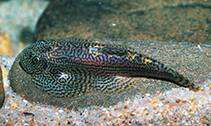Upload your photos and videos
Pictures | Google imageSewellia albisuera
Picture by Freyhof, J.
Pictures | Google imageSewellia albisuera
Picture by Freyhof, J.
Viet Nam country information
Common names:
[No common name]
Occurrence: native
Salinity: freshwater
Abundance: | Ref:
Importance: | Ref:
Aquaculture: | Ref:
Regulations: | Ref:
Uses: no uses
Comments: Found in the catchment of the River Thu Bon (Quang Nam Da Nang Province) whose estuary is located close to the city of Hoi An on the coast of Central Vietnam (Ref. 51729).
National Checklist:
Country Information: https://www.cia.gov/library/publications/resources/the-world-factbook/geos/vm.html
National Fisheries Authority:
Occurrences: Occurrences Point map
Main Ref: Freyhof, J., 2003
National Database:
Occurrence: native
Salinity: freshwater
Abundance: | Ref:
Importance: | Ref:
Aquaculture: | Ref:
Regulations: | Ref:
Uses: no uses
Comments: Found in the catchment of the River Thu Bon (Quang Nam Da Nang Province) whose estuary is located close to the city of Hoi An on the coast of Central Vietnam (Ref. 51729).
National Checklist:
Country Information: https://www.cia.gov/library/publications/resources/the-world-factbook/geos/vm.html
National Fisheries Authority:
Occurrences: Occurrences Point map
Main Ref: Freyhof, J., 2003
National Database:
Common names from other countries
Classification / Names Nombres comunes | Sinónimos | Catalog of Fishes(Género, Especie) | ITIS | CoL | WoRMS | Cloffa
> Cypriniformes (Carps) > Gastromyzontidae (Hillstream loaches)
Eponymy: Lieutenant-Colonel Robert Beresford Seymour Sewell CIE. [...] (Ref. 128868), visit book page.
More on author: Freyhof.
Eponymy: Lieutenant-Colonel Robert Beresford Seymour Sewell CIE. [...] (Ref. 128868), visit book page.
More on author: Freyhof.
Environment: milieu / climate zone / depth range / distribution range Ecología
; agua dulce demersal. Tropical
Distribución Países | Áreas FAO | Ecosistemas | Ocurrencias, apariciones | Point map | Introducciones | Faunafri
Asia: Viet Nam.
Tamaño / Peso / Age
Short description Claves de identificación | Morfología | Morfometría
Radios blandos dorsales (total) : 11; Radios blandos anales: 6; Vértebra: 31 - 32. Dorsum of head, body and paired fin bases with whitish reticulated or whitish spotted pattern; faint dark grey axial stripe covering three scale rows; skin around lateral line pores whitish; posterior part of pectoral fin with 5-7 faint annular bands; 20-21 branched pelvic fin rays; 49-54+2 lateral line scales; pelvic fin origin below dorsal fin origin; pectoral fin origin posterior to corner of mouth; pelvic fin reaching anal fin origin; small soft elevated patches of fine tubercles on first pectoral fin rays in males; tubercles on simple pectoral fin ray not enlarged; absence of cavity around mouth and absence of skin-fold between oropectoral membrane and ventral surface of head (Ref. 51729).
Inhabits rocky rapids and deep pools over sandy substrates. Also found in rocky pools isolated from the main river.
Life cycle and mating behavior Madurez | Reproducción | Puesta | Huevos | Fecundidad | Larva
Main reference
Upload your references | Referencias | Coordinador | Colaboradores
Freyhof, J., 2003. Sewellia albisuera, a new balitorid loach from Central Vietnam (Cypriniformes: Balitoridae). Ichthyol. Explor. Freshwat. 14(3):225-230. (Ref. 51729)
IUCN Red List Status (Ref. 130435: Version 2024-2)
Critically Endangered (CR) (A2c+3c; B1b(i,ii)); Date assessed: 04 September 2010
Threat to humans
Harmless
Human uses
Pesquerías: sin interés
FAO(Publication : search) | FishSource |
Más información
Trophic ecology
componentes alimenticios
Composición de la dieta
consumo de alimento
Food rations
Despredadores
componentes alimenticios
Composición de la dieta
consumo de alimento
Food rations
Despredadores
Ecology
Ecología
Home ranges
Ecología
Home ranges
Population dynamics
Coeficiente del crecimiento para
Max. ages / sizes
Length-weight rel.
Length-length rel.
Length-frequencies
Mass conversion
Reclutamiento
Abundancia
Coeficiente del crecimiento para
Max. ages / sizes
Length-weight rel.
Length-length rel.
Length-frequencies
Mass conversion
Reclutamiento
Abundancia
Life cycle
Reproducción
Madurez
Fecundidad
Puesta
Spawning aggregations
Huevos
Egg development
Larva
Dinámica larvaria
Reproducción
Madurez
Fecundidad
Puesta
Spawning aggregations
Huevos
Egg development
Larva
Dinámica larvaria
Anatomy
Superficie branquial
Brain
Otolith
Superficie branquial
Brain
Otolith
Physiology
Body composition
Nutrients
Consumo del oxígeno
Tipo de natación
Velocidad de natación
Visual pigments
Fish sound
Diseases & Parasites
Toxicity (LC50s)
Body composition
Nutrients
Consumo del oxígeno
Tipo de natación
Velocidad de natación
Visual pigments
Fish sound
Diseases & Parasites
Toxicity (LC50s)
Genetics
Genética
Heterozygosity
heritabilidad
Genética
Heterozygosity
heritabilidad
Human related
Aquaculture systems
Perfiles de acuicultura
Razas
Ciguatera cases
Stamps, coins, misc.
Aquaculture systems
Perfiles de acuicultura
Razas
Ciguatera cases
Stamps, coins, misc.
Herramientas
E-book | Guía de campo | Asistente para frecuencias de tallas | Herramienta de ciclo de vida | Mapa de puntos | Classification Tree
| Catch-MSY |
Special reports
Download XML
Fuentes de Internet
Aquatic Commons | BHL | Cloffa | Websites from users | Check FishWatcher | CISTI | Catalog of Fishes(Género, Especie) | DiscoverLife | ECOTOX | Faunafri | Fishtrace | GenBank(genome, nucleotide) | GloBI | GOBASE | | Google Books | Google Scholar | Google | IGFA World Record | MitoFish | Otolith Atlas of Taiwan Fishes | PubMed | Reef Life Survey | Scirus | SeaLifeBase | Árbol de la vida | Wikipedia(Go, búsqueda) | World Records Freshwater Fishing | Zoobank | Expediente Zoológico
Estimates based on models
Phylogenetic diversity index (Ref. 82804): PD50 = 0.5001 [Uniqueness, from 0.5 = low to 2.0 = high].
Bayesian length-weight: a=0.00617 (0.00268 - 0.01421), b=3.11 (2.91 - 3.31), in cm Total Length, based on LWR estimates for this (Sub)family-body shape (Ref. 93245).
Nivel trófico (Ref. 69278): 3.6 ±0.4 se; based on size and trophs of closest relatives
Fishing Vulnerability (Ref. 59153): Low vulnerability (10 of 100).




